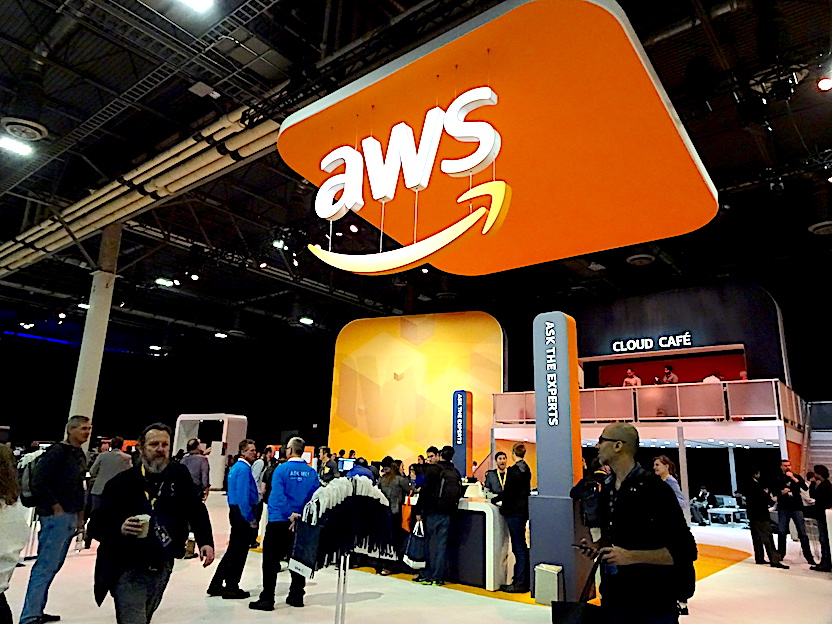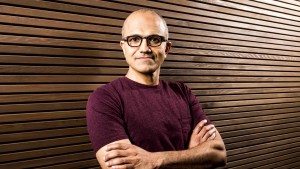 EMERGING TECH
EMERGING TECH
 EMERGING TECH
EMERGING TECH
 EMERGING TECH
EMERGING TECH
In a year in which the Nasdaq hit an all-time high, venture capital dollars flowed like cheap champagne and the majority of earnings surprises were on the upside, there were plenty of winners. These companies and technologies stood out for the scope of their accomplishment or speed of acceptance:
Holding onto a 40 percent-plus share in a $30 billion market that’s growing at 40 percent a year seems all but impossible, but by most accounts, Amazon Web Services Inc. actually grew its market share in 2017. With an annual run rate of $18 billion in cloud infrastructure-as-a-service, the company is the size of its next five largest IaaS competitors combined, according to Synergy Research. Amazon pursues a shock-and-awe product strategy to feed its customers’ seemingly insatiable appetite for more services. At its sixth annual re:Invent conference in November, it rolled out 22 new cloud services at the same time. Amazon faces plenty of competition from a reinvigorated Microsoft Corp., a determined Google LLC and cloud newcomers such as Oracle Corp., but there’s no sign that it’s ready to cede ground to anybody.
 The slumbering giant has awakened. Under the leadership of Chief Executive Satya Nadella (pictured), Microsoft Corp. has overcome its addiction to packaged software, embraced the open source community and poured resources into its cloud business. The results speak for themselves. Revenue from Microsoft’s Azure cloud nearly doubled from a year ago. Office 365 in the cloud long ago surpassed the packaged software business and Microsoft’s annual combined IaaS and software-a-service revenue of more than $20 billion exceeds that of any other cloud company. Its stock is at an all-time high, as is its confidence.
The slumbering giant has awakened. Under the leadership of Chief Executive Satya Nadella (pictured), Microsoft Corp. has overcome its addiction to packaged software, embraced the open source community and poured resources into its cloud business. The results speak for themselves. Revenue from Microsoft’s Azure cloud nearly doubled from a year ago. Office 365 in the cloud long ago surpassed the packaged software business and Microsoft’s annual combined IaaS and software-a-service revenue of more than $20 billion exceeds that of any other cloud company. Its stock is at an all-time high, as is its confidence.
Yeah, that fake news thing is a big deal, but only because Facebook Inc.’s influence is so vast that its decisions about how to engineer its news feed can swing elections. The company’s business certainly isn’t suffering from all the negative scrutiny on the political front. Profits in the most recent quarter jumped nearly 80 percent on revenues of more than $10 billion. Its stock chart looks like a stairway to heaven. By most accounts, Facebook and Google now all but control the online advertising market. That’s one reason Facebook’s business dealings with Russia and reluctance to acknowledge its power over public opinion have drawn so much criticism. Facebook has no meaningful competition in its core market besides Google, but its growth rate is slowing and it’s already betting on new areas such as virtual reality for growth. Acquisitions are likely to continue to be a principal driver.

Nvidia’s V100 GPU chip (Photo: Nvidia)
Two years ago, Nvidia Corp. was a profitable but small provider of graphics processing unit chips for accelerator boards favored by gamers. Then some savvy hardware makers got the idea that GPUs could be used to boost high-performance computers just as the speed-doubling effects of Moore’s Law were beginning to fizzle. Their epiphany came just as machine learning and artificial intelligence developers started screaming for faster, parallel processing machines, using them to develop the image and speech recognition that have supercharged smartphones, web search and more. The result is that Nvidia is now a major force in the so-called “hyperscale” data center, which is a $2 billion chunk of its business. Data center revenues grew 175 percent in the most recent quarter as it once again crushed earnings estimates. Its stock is up sixfold over the past 24 months. Its success prompted once-bitter rivals Intel Corp. and Advanced Micro Devices Inc. to team up last month to develop an alternative. That’s what you call making an impact.
Whether or not you buy into the hype over whether artificial intelligence is finally a real thing, there can be no doubt the machine learning is real and is having an impact. Machine learning algorithms mine data looking for patterns, keeping the combinations that show promise and discarding the others in a sort of high-speed trial-and-error process. Over time, the machine refines its understanding of the problem domain and makes better choices in a primitive but effective emulation of how the brain learns. Machine learning is a core component of such hot technologies as self-driving vehicles, voice-response systems and automated translation. It will soon be part of many more consumer devices. Its popularity has been fueled by moves by such giants at Facebook, Microsoft and Google to open-source their machine learning libraries. Major cloud companies are offering it as a service, and chief information officers are buying in big.
Container technology, which allows software to move easily between platforms, including on-premises data centers and the cloud, is barely three years old. But by the end of the year, up to 80 percent of enterprises expect to be in production with it. More than half are using some form of orchestration to manage containers, according to 451 Research LLC, and Kubernetes is the clear technology of choice. Developed and released to open source by Google, Kubernetes provides mechanisms for deploying, maintaining and scaling container-based applications. The Open Container Initiative quickly rallied to set standards, and Kubernetes is now supported by all major cloud providers and even rival Docker Inc. The KubeCon + CloudNativeCon conference drew 4,100 attendees this year. “In my 30-year career, I’ve never seen a technology adopted as quickly as containers,” said Pete Abrams, chief operating officer of Instana Inc.
For information technology managers who were just getting their heads wrapped around the idea of moving server workloads to the cloud, the concept of doing away with servers entirely may seem like too much to handle. The good news is that serverless computing isn’t a wholesale infrastructure replacement, but rather a different way of building cloud applications that doesn’t require the complexity of messing with configuring servers and storage in the cloud. Instead, containerized services are called when needed and quickly shut down, often in microseconds. That makes applications more flexible and saves users money because they’re only charged for the time the server is active. Amazon Web Services jump-started the notion two years ago with the introduction of Lambda and is driving it hard. “The torrid pace of adoption and innovation in the serverless space has totally blown us away,” said AWS Chief Executive Andy Jassy. For organizations adopting microservices and containers, serverless computing deserves, and is getting, a close look.
 Lost in this year’s mind-bending speculative frenzy around bitcoin is the fact that almost no one is using it for its original intended purpose, which is as currency. So what makes bitcoin a winner? Simply the fact that cryptocurrencies have now become a force to contend with, and financial institutions are struggling to understand whether they constitute a new line of business or their worst nightmare. Bitcoin and its more than 1,000 siblings enable trusted transactions to be conducted between anonymous parties without the need for middlemen or market makers. Cryptocurrency transactions are fast, secure and auditable. Their anonymity is what has regulators freaking out — that and the enormous energy cost and potential environmental impact of mining them. Cryptocurrency markets may be in chaos right now — and in a potential reckoning this week, bitcoin itself saw a big swoon after reaching a high of more than $19,000 Dec. 16 — but there’s no question they have started to shake up the established financial order.
Lost in this year’s mind-bending speculative frenzy around bitcoin is the fact that almost no one is using it for its original intended purpose, which is as currency. So what makes bitcoin a winner? Simply the fact that cryptocurrencies have now become a force to contend with, and financial institutions are struggling to understand whether they constitute a new line of business or their worst nightmare. Bitcoin and its more than 1,000 siblings enable trusted transactions to be conducted between anonymous parties without the need for middlemen or market makers. Cryptocurrency transactions are fast, secure and auditable. Their anonymity is what has regulators freaking out — that and the enormous energy cost and potential environmental impact of mining them. Cryptocurrency markets may be in chaos right now — and in a potential reckoning this week, bitcoin itself saw a big swoon after reaching a high of more than $19,000 Dec. 16 — but there’s no question they have started to shake up the established financial order.
“Alexa, tell me about the future.” In the year following Microsoft’s announcement that its automated voice recognition is now comparable to that of a human being, voice capabilities entered the home in a big way. Next stop is the enterprise. Amazon Inc. has doubled down on its lead with a slew of new devices being churned out by an army of more than 5,000 people working on the technology. With Alexa for Business, it’s attempting to bring the technology into office settings. In a market that’s expected to top $18 billion annually by 2023, it will have plenty of company. Nuance Communications Inc. has been selling voice recognition to businesses like hospitals and legal firms for years. Google, which has earned high marks for the quality of its voice technology for mobile devices, is embedding voice recognition into its own business applications. It open-sourced its speech recognition data set for machine learning applications last summer. Enterprise software companies have been biding their time, perhaps seeing voice interfaces as more of a garnish than a core feature. The action is more likely to be concentrated in vertical markets, where professionals who work with their hands can’t be bothered with a keyboard.
With Mike Wheatley, Duncan Riley and Robert Hof
THANK YOU